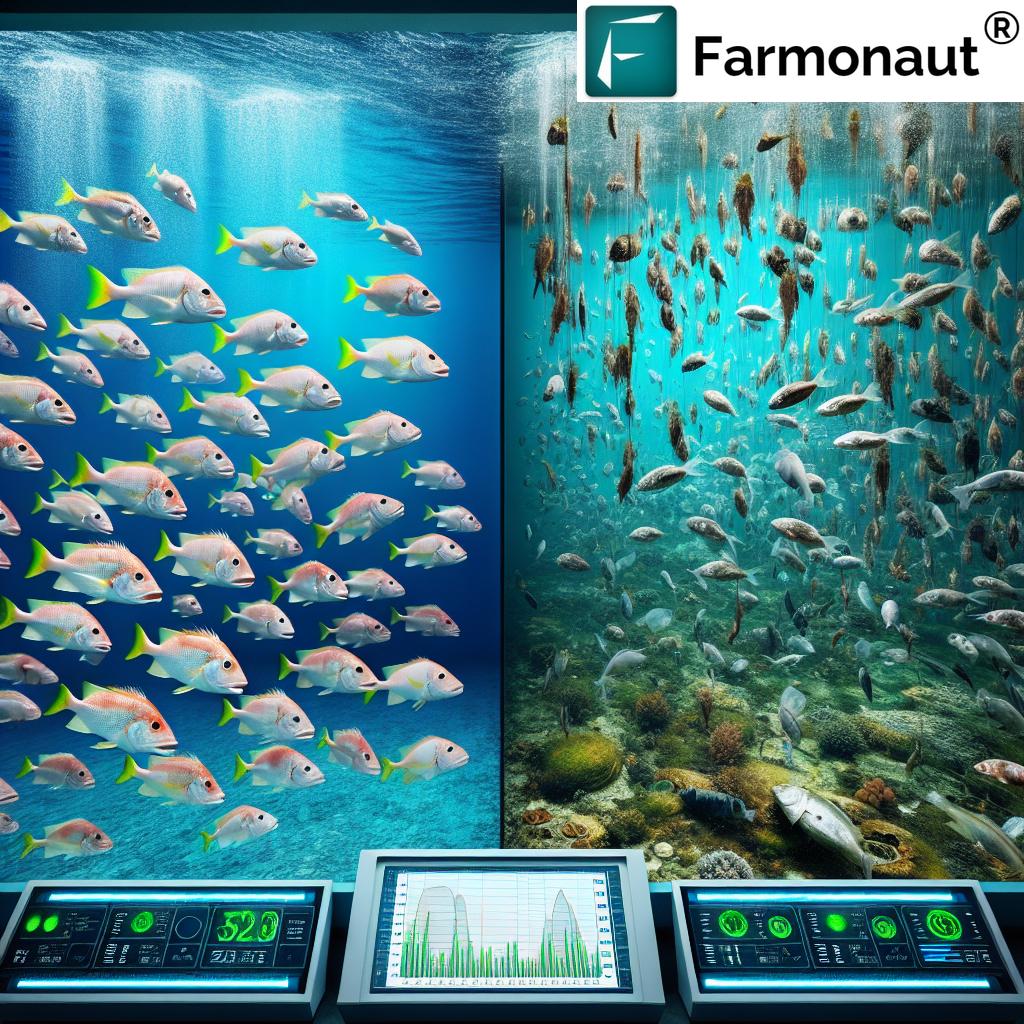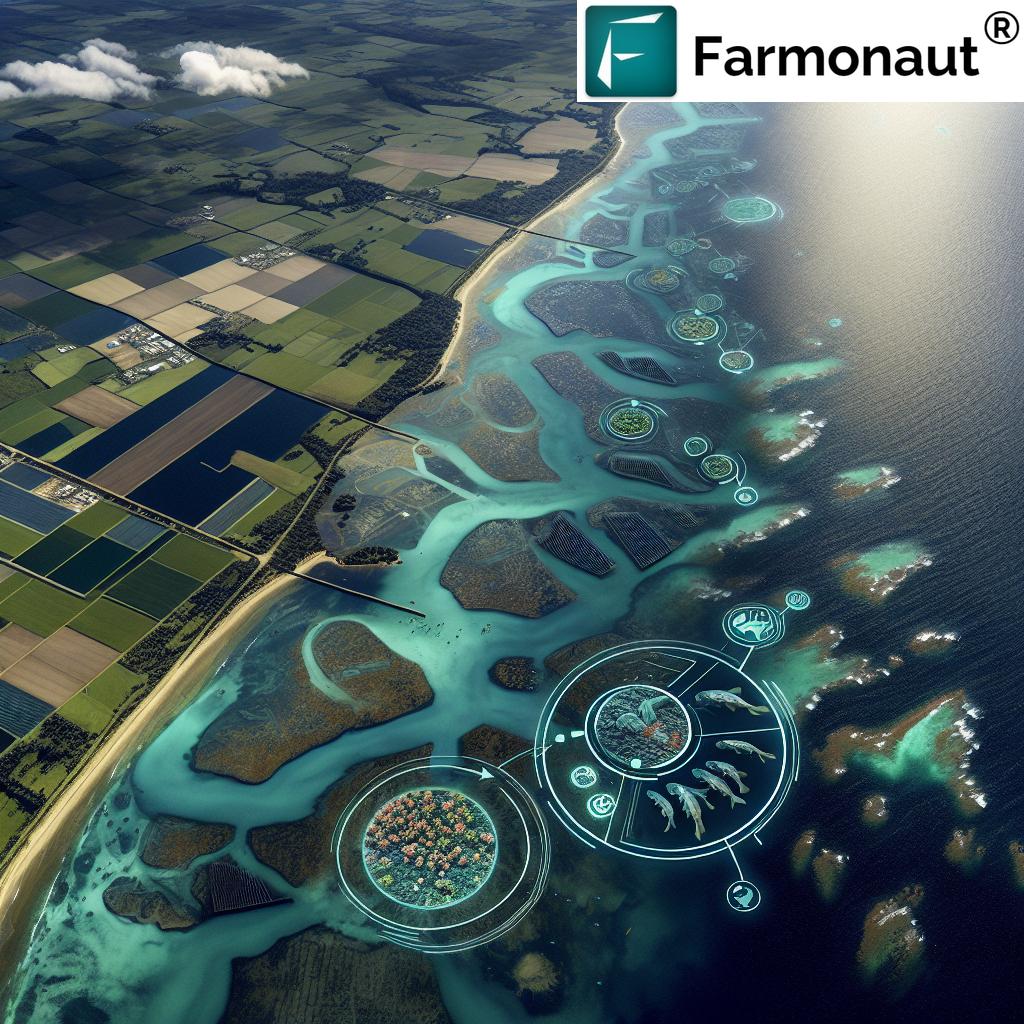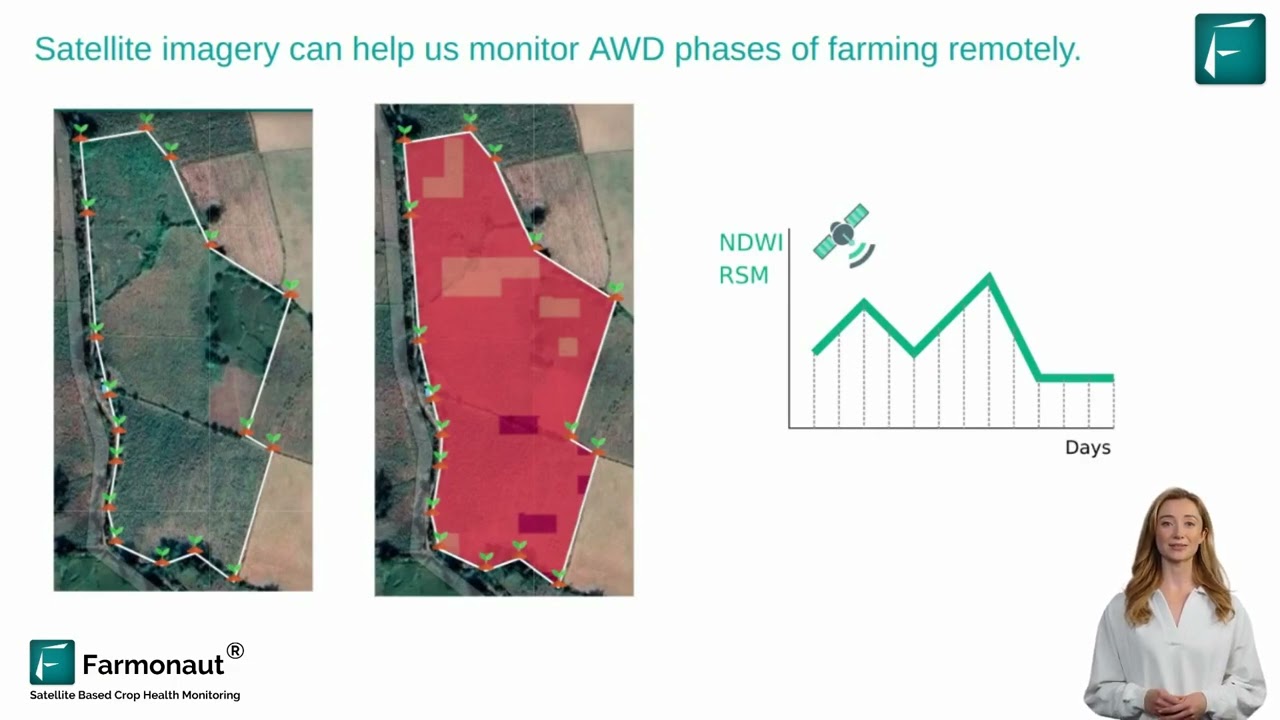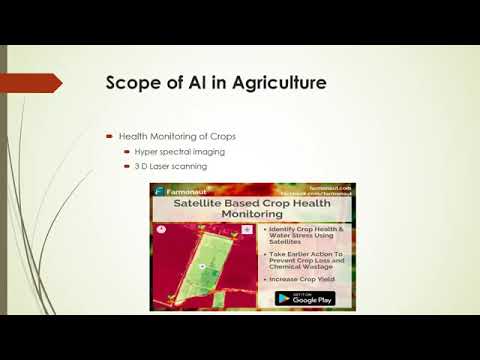Farmonaut’s Guide: Sustainable Aquaculture Management – Preventing Mass Fish Die-Offs and Protecting Marine Ecosystems

“Rapid reporting of mass fish die-offs can increase environmental crisis response effectiveness by up to 80%.”
Welcome to Farmonaut’s comprehensive guide on sustainable aquaculture management and the critical issue of mass fish die-offs. As pioneers in agricultural technology, we at Farmonaut are committed to leveraging our expertise to address pressing environmental concerns, including those in aquatic ecosystems. In this blog post, we’ll explore the challenges facing our marine environments and the innovative solutions that are revolutionizing aquaculture practices.
Understanding Mass Fish Die-Offs: A Growing Environmental Crisis
Mass fish die-offs are catastrophic events that can devastate aquatic ecosystems and the fishing industry. These incidents, often triggered by a combination of environmental stressors and human activities, pose significant challenges to marine biodiversity and sustainable fisheries management. As we delve into this critical issue, it’s essential to understand the causes, impacts, and potential solutions to prevent and mitigate these ecological disasters.
Causes of Mass Fish Die-Offs
- Water Quality Deterioration: Pollution, algal blooms, and oxygen depletion
- Climate Change: Rising water temperatures and altered ocean chemistry
- Disease Outbreaks: Rapid spread of pathogens in densely populated aquaculture systems
- Overfishing: Disruption of natural ecosystem balance
- Habitat Destruction: Loss of critical spawning and nursery grounds
The interplay of these factors can create perfect storm conditions, leading to sudden and large-scale fish mortality events. Recognizing the early warning signs and implementing proactive management strategies are crucial in preventing these ecological catastrophes.
The Importance of Rapid Reporting and Environmental Crisis Response
When it comes to mass fish die-offs, time is of the essence. Rapid reporting and swift environmental crisis response can make the difference between containment and catastrophe. At Farmonaut, we understand the critical nature of timely information in managing aquatic emergencies.
Benefits of Rapid Reporting
- Early Intervention: Quick identification allows for immediate action
- Damage Limitation: Containment measures can be implemented swiftly
- Data Collection: Valuable information can be gathered for future prevention
- Resource Mobilization: Appropriate personnel and equipment can be deployed rapidly
Our advanced satellite-based monitoring systems at Farmonaut play a crucial role in detecting anomalies in aquatic environments, enabling faster response times and more effective crisis management.
Sustainable Aquaculture Practices: A Path to Healthier Aquatic Ecosystems
Sustainable aquaculture is not just a buzzword; it’s a necessity for the future of our marine resources. By implementing responsible practices, we can significantly reduce the risk of mass fish die-offs while ensuring the long-term viability of the aquaculture industry.
Key Principles of Sustainable Aquaculture
- Ecosystem-Based Management: Considering the entire ecosystem in aquaculture planning
- Responsible Resource Use: Efficient feed management and water conservation
- Disease Prevention: Implementing robust biosecurity measures
- Genetic Diversity: Maintaining diverse broodstock to improve resilience
- Technology Integration: Utilizing advanced monitoring and control systems
At Farmonaut, we’re committed to supporting sustainable aquaculture through our innovative agtech solutions. Our satellite-based monitoring and AI-driven advisory systems help aquaculture managers make informed decisions that promote both productivity and environmental stewardship.

Biosecurity Measures: The First Line of Defense
Biosecurity is paramount in preventing disease outbreaks that can lead to mass fish die-offs. Implementing comprehensive biosecurity protocols can significantly reduce the risk of pathogen introduction and spread within aquaculture facilities.
Essential Biosecurity Practices
- Quarantine Procedures: Isolating new stock to prevent disease introduction
- Sanitation Protocols: Regular cleaning and disinfection of equipment and facilities
- Staff Training: Educating personnel on biosecurity best practices
- Visitor Controls: Limiting and managing access to aquaculture sites
- Health Monitoring: Regular health checks and disease surveillance
Farmonaut’s digital solutions can assist in managing and documenting biosecurity measures, ensuring consistent implementation and providing valuable data for continuous improvement.
Innovative Water Quality Monitoring Techniques
Maintaining optimal water quality is crucial for preventing mass fish die-offs and ensuring the health of aquatic ecosystems. Advanced monitoring techniques allow for real-time assessment and rapid response to potential issues.
Cutting-Edge Water Quality Monitoring Tools
- Remote Sensing Technology: Satellite-based monitoring for large-scale assessment
- IoT Sensors: Continuous in-situ monitoring of key parameters
- AI-Powered Analytics: Predictive modeling for early warning systems
- Automated Sampling Systems: Regular collection and analysis of water samples
- Bioindicators: Using sensitive species to detect environmental changes
Farmonaut’s platform integrates these advanced monitoring techniques, providing aquaculture managers with comprehensive, real-time data on water quality parameters essential for maintaining healthy fish populations.
Protecting Marine Biodiversity: A Holistic Approach
Preserving marine biodiversity is essential for maintaining healthy, resilient aquatic ecosystems. A holistic approach to aquaculture management considers not only the immediate production environment but also its impact on surrounding ecosystems.
Strategies for Biodiversity Conservation in Aquaculture
- Habitat Preservation: Protecting critical marine habitats near aquaculture sites
- Species Selection: Choosing native or well-adapted species for cultivation
- Integrated Multi-Trophic Aquaculture: Combining species from different trophic levels
- Escape Prevention: Implementing robust containment systems to prevent farmed species from entering natural ecosystems
- Sustainable Feed Sources: Using responsibly sourced feed ingredients to reduce pressure on wild fish stocks
At Farmonaut, we recognize the importance of biodiversity in maintaining healthy aquatic ecosystems. Our technology supports biodiversity conservation efforts by providing tools for environmental impact assessment and sustainable aquaculture planning.
The Role of Digital Mapping and Remote Sensing in Aquaculture Management
Digital mapping and remote sensing technologies have revolutionized the way we monitor and manage aquatic environments. These tools provide unprecedented insights into large-scale ecosystem dynamics and potential risks to fish populations.
Applications of Digital Mapping and Remote Sensing in Aquaculture
- Site Selection: Identifying optimal locations for aquaculture development
- Environmental Impact Assessment: Monitoring changes in surrounding ecosystems
- Disease Outbreak Tracking: Mapping the spread of pathogens across regions
- Algal Bloom Detection: Early warning for potential oxygen depletion events
- Stock Assessment: Estimating fish populations in open water aquaculture
Farmonaut’s advanced satellite-based monitoring systems integrate these technologies, providing aquaculture managers with powerful tools for risk identification and proactive management.
“Sustainable aquaculture practices can reduce the risk of fish diseases by 60% compared to traditional methods.”
Data-Driven Decision Making in Fisheries Management
In the era of big data, informed decision-making is crucial for effective fisheries management. By leveraging comprehensive data sets and advanced analytics, managers can make more accurate predictions and implement targeted interventions to prevent mass fish die-offs.
Key Benefits of Data-Driven Fisheries Management
- Improved Resource Allocation: Targeting interventions where they’re most needed
- Enhanced Predictive Capabilities: Anticipating potential issues before they escalate
- Evidence-Based Policy Making: Developing regulations grounded in solid data
- Optimized Production: Fine-tuning aquaculture practices for maximum efficiency and sustainability
- Adaptive Management: Quickly adjusting strategies based on real-time information
Farmonaut’s AI-powered advisory system, Jeevn AI, exemplifies the power of data-driven decision making in aquaculture. By analyzing vast amounts of data from multiple sources, it provides actionable insights for sustainable fisheries management.
Research and Innovation in Aquatic Ecosystem Management
Ongoing research and innovation are vital for addressing the complex challenges facing aquatic ecosystems. From developing new disease-resistant fish strains to pioneering eco-friendly aquaculture technologies, scientific advancements play a crucial role in preventing mass fish die-offs and promoting sustainable aquaculture practices.
Emerging Areas of Research in Aquaculture
- Genetic Improvement: Breeding programs for resilient and disease-resistant fish
- Alternative Feed Sources: Developing sustainable protein sources for aquaculture feed
- Recirculating Aquaculture Systems (RAS): Advancing closed-loop production technologies
- Microbiome Management: Understanding and manipulating beneficial microorganisms in aquaculture environments
- Nanotechnology Applications: Developing targeted treatments and diagnostics for fish health
At Farmonaut, we stay at the forefront of aquaculture research, continuously updating our technology to incorporate the latest scientific findings and innovative approaches to sustainable fish farming.
Ecosystem Restoration: Rebuilding Healthy Aquatic Environments
In cases where aquatic ecosystems have been severely impacted by mass fish die-offs or other environmental stressors, restoration efforts are crucial. Ecosystem restoration not only helps recover biodiversity but also enhances the resilience of aquatic environments against future threats.
Key Aspects of Aquatic Ecosystem Restoration
- Habitat Reconstruction: Rebuilding critical habitats such as coral reefs and mangroves
- Species Reintroduction: Carefully managed programs to reintroduce native species
- Pollution Remediation: Removing contaminants and improving water quality
- Invasive Species Management: Controlling non-native species that disrupt ecosystem balance
- Community Engagement: Involving local communities in restoration efforts for long-term success
Farmonaut’s digital mapping and monitoring tools can assist in planning and tracking the progress of ecosystem restoration projects, ensuring that efforts are targeted and effective.
The Future of Sustainable Aquaculture: Trends and Predictions
As we look to the future, the aquaculture industry is poised for significant transformation. Emerging technologies and evolving practices are shaping a more sustainable and resilient approach to fish farming and marine resource management.
Future Trends in Sustainable Aquaculture
- Offshore Aquaculture: Moving fish farms into deeper waters to reduce environmental impact
- AI and Robotics: Automating routine tasks and enhancing monitoring capabilities
- Blockchain for Traceability: Ensuring transparency and accountability in seafood supply chains
- Integrated Coastal Zone Management: Holistic approaches to balancing aquaculture with other coastal activities
- Climate-Resilient Aquaculture: Developing strategies to adapt to changing environmental conditions
Farmonaut is committed to driving innovation in sustainable aquaculture. Our ongoing research and development efforts focus on integrating these emerging trends into our platform, ensuring that we continue to provide cutting-edge solutions for the aquaculture industry.
Comparison of Aquaculture Management Techniques
| Management Technique | Description | Benefits | Challenges | Environmental Impact Score (1-10) |
|---|---|---|---|---|
| Water Quality Monitoring | Continuous assessment of water parameters | Early detection of issues, improved fish health | Equipment cost, data interpretation | 9 |
| Biosecurity Measures | Protocols to prevent disease introduction and spread | Reduced disease outbreaks, improved production | Implementation costs, staff training | 8 |
| Disease Prevention | Vaccination, probiotics, and health management | Lower mortality rates, reduced antibiotic use | Research costs, regulatory approval | 7 |
| Stocking Density Management | Optimizing fish populations in farming units | Improved growth rates, reduced stress | Balancing production goals with fish welfare | 6 |
| Ecosystem-Based Management | Holistic approach considering entire ecosystem | Long-term sustainability, biodiversity protection | Complexity, stakeholder coordination | 10 |
Farmonaut’s Role in Revolutionizing Aquaculture Management
At Farmonaut, we’re dedicated to transforming the aquaculture industry through innovative technology and data-driven solutions. Our comprehensive platform offers a range of tools designed to support sustainable aquaculture practices and prevent mass fish die-offs.
Key Features of Farmonaut’s Aquaculture Management Solutions
- Satellite-Based Monitoring: Real-time tracking of water quality and environmental conditions
- AI-Powered Advisory System: Personalized recommendations for optimal farm management
- Blockchain-Based Traceability: Ensuring transparency and accountability in seafood supply chains
- Resource Management Tools: Optimizing feed usage, water consumption, and energy efficiency
- Environmental Impact Assessment: Monitoring and minimizing the ecological footprint of aquaculture operations
By leveraging these advanced technologies, Farmonaut empowers aquaculture managers to make informed decisions, respond quickly to potential threats, and maintain healthy, productive aquatic ecosystems.
Conclusion: A Sustainable Future for Aquaculture
As we face the growing challenges of climate change, overfishing, and environmental degradation, the importance of sustainable aquaculture management cannot be overstated. By embracing innovative technologies, implementing robust biosecurity measures, and adopting ecosystem-based approaches, we can prevent mass fish die-offs and protect our vital marine resources for future generations.
Farmonaut stands at the forefront of this revolution in aquaculture management. Our comprehensive suite of tools and services empowers farmers, researchers, and policymakers to make data-driven decisions that promote both productivity and environmental stewardship. As we continue to innovate and adapt to the changing needs of the industry, we remain committed to our mission of making precision agriculture accessible and affordable to all.
Together, we can build a more sustainable and resilient future for aquaculture, ensuring the health of our oceans and the security of our food systems for years to come.
FAQ Section
- What causes mass fish die-offs?
Mass fish die-offs can be caused by various factors including water pollution, algal blooms, oxygen depletion, disease outbreaks, and extreme weather events. - How can aquaculture managers prevent mass fish die-offs?
Managers can prevent die-offs by implementing robust water quality monitoring systems, maintaining proper stocking densities, employing biosecurity measures, and using advanced disease prevention techniques. - What role does technology play in sustainable aquaculture?
Technology plays a crucial role through satellite monitoring, AI-powered advisory systems, IoT sensors for real-time data collection, and blockchain for supply chain transparency. - How does Farmonaut contribute to sustainable aquaculture?
Farmonaut provides advanced satellite-based monitoring, AI-driven insights, and resource management tools that help aquaculture managers make informed decisions and maintain healthy aquatic ecosystems. - What are the benefits of ecosystem-based management in aquaculture?
Ecosystem-based management promotes long-term sustainability, protects biodiversity, enhances resilience to environmental stressors, and ensures a holistic approach to aquaculture development.
For more information on how Farmonaut can revolutionize your aquaculture management practices, visit our website or download our mobile app:
For developers interested in integrating our powerful API into their own systems, check out our API documentation and developer resources.



















